2004 Hyundai Coupe airbag
[x] Cancel search: airbagPage 193 of 389
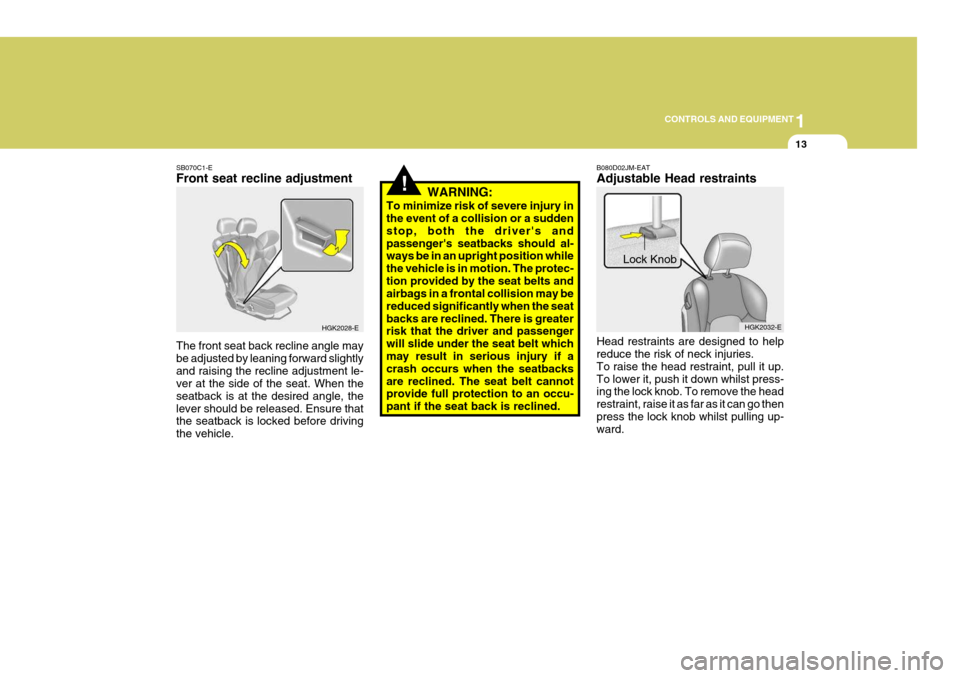
1
CONTROLS AND EQUIPMENT
13
!
B080D02JM-EAT Adjustable Head restraints Head restraints are designed to help reduce the risk of neck injuries. To raise the head restraint, pull it up.To lower it, push it down whilst press- ing the lock knob. To remove the head restraint, raise it as far as it can go thenpress the lock knob whilst pulling up- ward. Lock Knob
HGK2032-E
SB070C1-E Front seat recline adjustment
HGK2028-E
The front seat back recline angle may be adjusted by leaning forward slightlyand raising the recline adjustment le- ver at the side of the seat. When the seatback is at the desired angle, thelever should be released. Ensure that the seatback is locked before driving the vehicle. WARNING:
To minimize risk of severe injury in the event of a collision or a sudden stop, both the driver's andpassenger's seatbacks should al- ways be in an upright position while the vehicle is in motion. The protec-tion provided by the seat belts and airbags in a frontal collision may be reduced significantly when the seatbacks are reclined. There is greater risk that the driver and passenger will slide under the seat belt which may result in serious injury if a crash occurs when the seatbacksare reclined. The seat belt cannot provide full protection to an occu- pant if the seat back is reclined.
Page 203 of 389
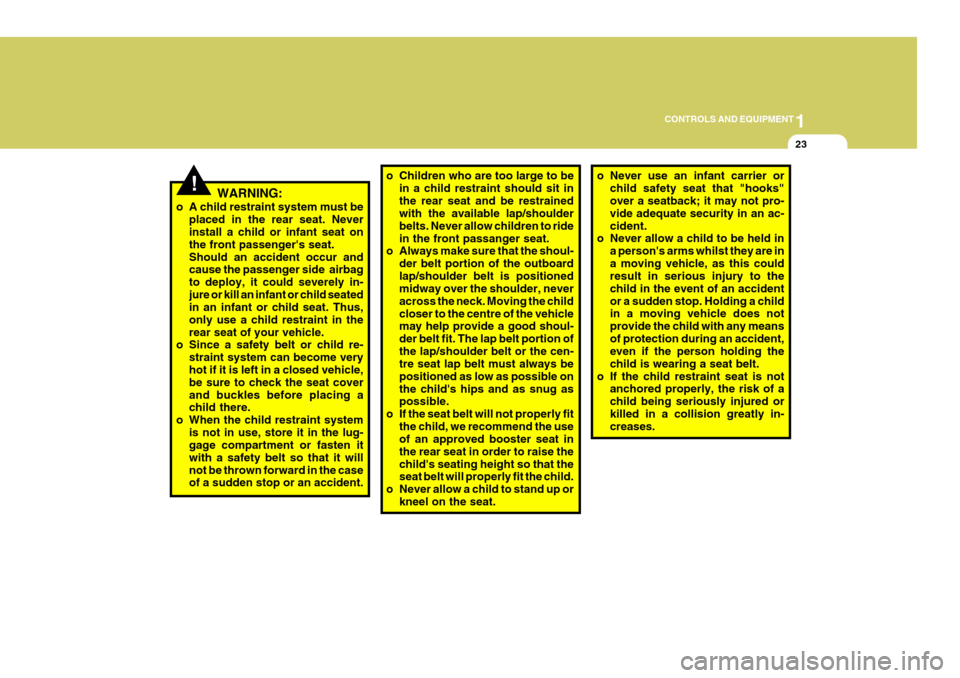
1
CONTROLS AND EQUIPMENT
23
!WARNING:
o A child restraint system must be placed in the rear seat. Never install a child or infant seat on the front passenger's seat.Should an accident occur and cause the passenger side airbag to deploy, it could severely in-jure or kill an infant or child seated in an infant or child seat. Thus, only use a child restraint in therear seat of your vehicle.
o Since a safety belt or child re-
straint system can become very hot if it is left in a closed vehicle, be sure to check the seat coverand buckles before placing a child there.
o When the child restraint system is not in use, store it in the lug-gage compartment or fasten it with a safety belt so that it willnot be thrown forward in the case of a sudden stop or an accident. o Never use an infant carrier or
child safety seat that "hooks"over a seatback; it may not pro- vide adequate security in an ac-cident.
o Never allow a child to be held in
a person's arms whilst they are ina moving vehicle, as this could result in serious injury to the child in the event of an accidentor a sudden stop. Holding a child in a moving vehicle does not provide the child with any meansof protection during an accident, even if the person holding the child is wearing a seat belt.
o If the child restraint seat is not anchored properly, the risk of achild being seriously injured orkilled in a collision greatly in- creases.
o Children who are too large to be
in a child restraint should sit in the rear seat and be restrained with the available lap/shoulder belts. Never allow children to ridein the front passanger seat.
o Always make sure that the shoul-
der belt portion of the outboardlap/shoulder belt is positioned midway over the shoulder, never across the neck. Moving the childcloser to the centre of the vehicle may help provide a good shoul- der belt fit. The lap belt portion ofthe lap/shoulder belt or the cen- tre seat lap belt must always be positioned as low as possible onthe child's hips and as snug as possible.
o If the seat belt will not properly fit the child, we recommend the useof an approved booster seat in the rear seat in order to raise thechild's seating height so that the seat belt will properly fit the child.
o Never allow a child to stand up or kneel on the seat.
Page 204 of 389
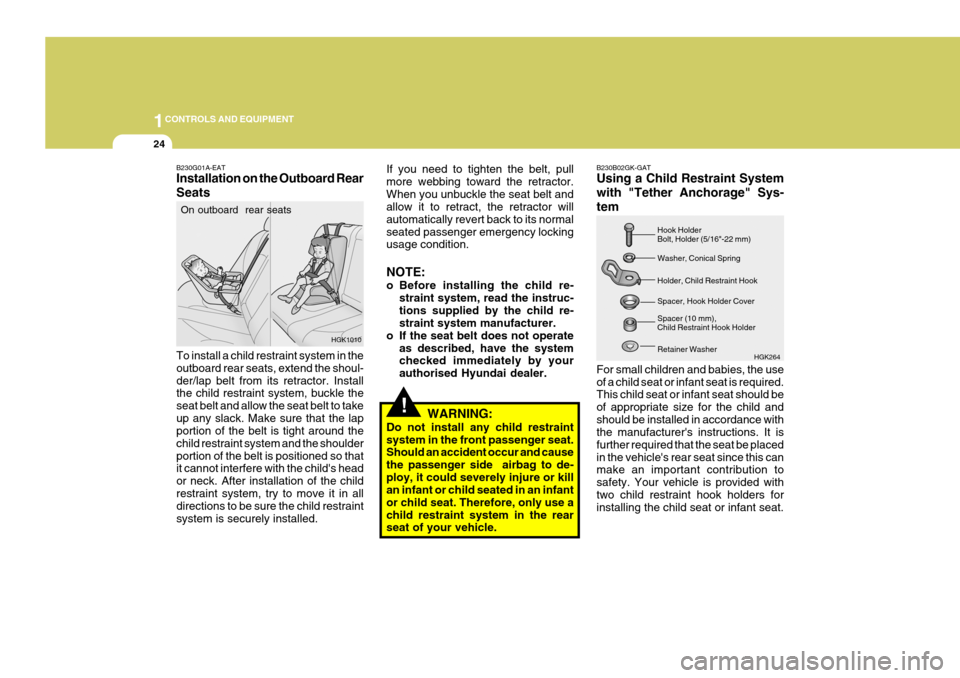
1CONTROLS AND EQUIPMENT
24
!
If you need to tighten the belt, pull more webbing toward the retractor.When you unbuckle the seat belt and allow it to retract, the retractor will automatically revert back to its normalseated passenger emergency locking usage condition. NOTE:
o Before installing the child re-
straint system, read the instruc- tions supplied by the child re- straint system manufacturer.
o If the seat belt does not operate
as described, have the systemchecked immediately by your authorised Hyundai dealer.
WARNING:
Do not install any child restraintsystem in the front passenger seat. Should an accident occur and cause the passenger side airbag to de-ploy, it could severely injure or kill an infant or child seated in an infant or child seat. Therefore, only use achild restraint system in the rear seat of your vehicle. B230B02GK-GAT Using a Child Restraint System with "Tether Anchorage" Sys-tem For small children and babies, the use of a child seat or infant seat is required. This child seat or infant seat should be of appropriate size for the child andshould be installed in accordance with the manufacturer's instructions. It is further required that the seat be placedin the vehicle's rear seat since this can make an important contribution to safety. Your vehicle is provided withtwo child restraint hook holders for installing the child seat or infant seat.
HGK264
Hook Holder Bolt, Holder (5/16"-22 mm) Washer, Conical Spring Holder, Child Restraint Hook Spacer, Hook Holder Cover Spacer (10 mm), Child Restraint Hook Holder Retainer Washer
B230G01A-EAT Installation on the Outboard Rear Seats To install a child restraint system in the outboard rear seats, extend the shoul-der/lap belt from its retractor. Install the child restraint system, buckle the seat belt and allow the seat belt to takeup any slack. Make sure that the lap portion of the belt is tight around the child restraint system and the shoulderportion of the belt is positioned so that it cannot interfere with the child's head or neck. After installation of the childrestraint system, try to move it in all directions to be sure the child restraint system is securely installed.On outboard rear seats
HGK1010
Page 208 of 389
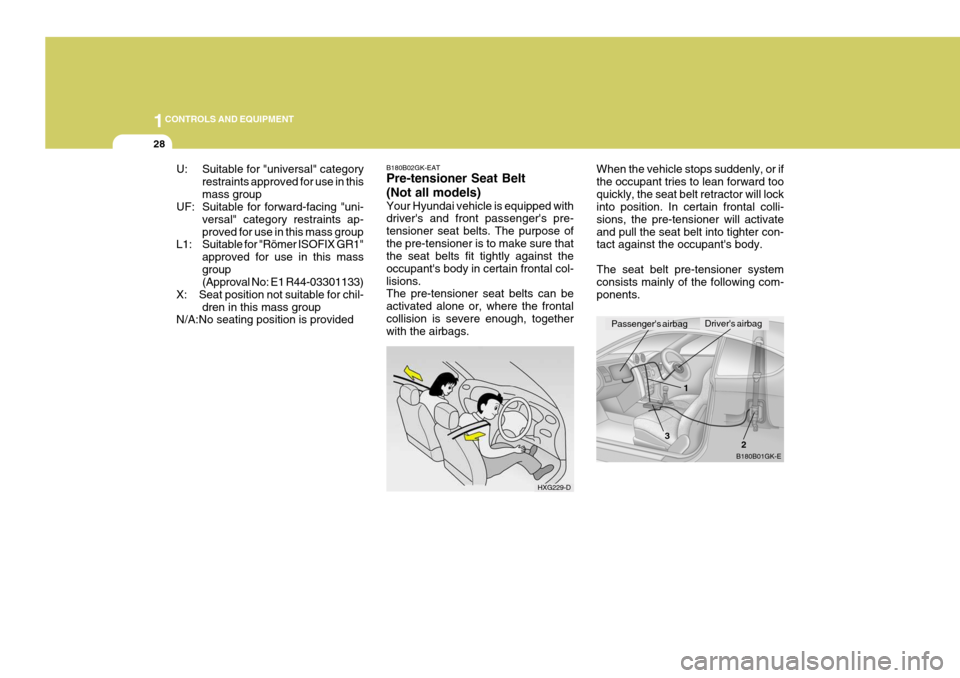
1CONTROLS AND EQUIPMENT
28
B180B02GK-EAT Pre-tensioner Seat Belt (Not all models) Your Hyundai vehicle is equipped with driver's and front passenger's pre- tensioner seat belts. The purpose ofthe pre-tensioner is to make sure that the seat belts fit tightly against the occupant's body in certain frontal col-lisions. The pre-tensioner seat belts can be activated alone or, where the frontalcollision is severe enough, together with the airbags. When the vehicle stops suddenly, or if the occupant tries to lean forward tooquickly, the seat belt retractor will lock into position. In certain frontal colli- sions, the pre-tensioner will activateand pull the seat belt into tighter con- tact against the occupant's body. The seat belt pre-tensioner system consists mainly of the following com- ponents.
HXG229-D B180B01GK-E
Driver's airbag
1
2
3
Passenger's airbag
U: Suitable for "universal" category
restraints approved for use in this mass group
UF: Suitable for forward-facing "uni-
versal" category restraints ap-proved for use in this mass group
L1: Suitable for "Römer ISOFIX GR1"
approved for use in this massgroup (Approval No: E1 R44-03301133)
X: Seat position not suitable for chil- dren in this mass group
N/A:No seating position is provided
Page 209 of 389

1
CONTROLS AND EQUIPMENT
29
!
!
NOTE:
o Both the driver's and front
passenger's pre-tensioner seat belts will be activated in certainfrontal collisions. The pre- tensioner seat belts can be acti- vated alone or, where the frontalcollision is severe enough, to- gether with the airbags.
o When the pre-tensioner seat belts are activated, a loud noise maybe heard and fine dust, which may appear to be smoke, may bevisible in the passenger compart- ment. These are normal operat- ing conditions and are not haz-ardous.
o Although it is harmless, the fine
dust may cause skin irritationand should not be breathed for prolonged periods. Wash your hands and face thoroughly afteran accident in which the pre- tensioner seat belts were acti- vated. CAUTION:
o Because the sensor that activates the SRS airbag is connected withpre-tensioner seat belt, the SRSairbag warning light on the instrument panel will come on for approximately 6 seconds af-ter the ignition key has been turned to the "ON" position, and then it should turn off.
o If pre-tensioner seat belt is not working properly, this warninglight will illuminate even if there is no malfunction of the SRS airbag. If the SRS airbag warninglight does not illuminate when the ignition key is turned to "ON", or if it remains illuminated aftercoming for approximately 6 sec- onds, or if it illuminates while the vehicle is being driven, pleasehave an authorized Hyundai dealer inspect the pre-tensioner seat belts and SRS airbag sys-tem as soon as possible.
AIR
BAG
Their locations are shown in the illus- tration.
1. SRS airbag warning light
2. Seat belt pre-tensioner assembly
3. SRS control module
WARNING:
To obtain maximum benefit from apre-tensioner seat belt:
1. The seat belt must be worn cor- rectly.
2. The seat belt must be adjusted to
the correct position.
Page 210 of 389
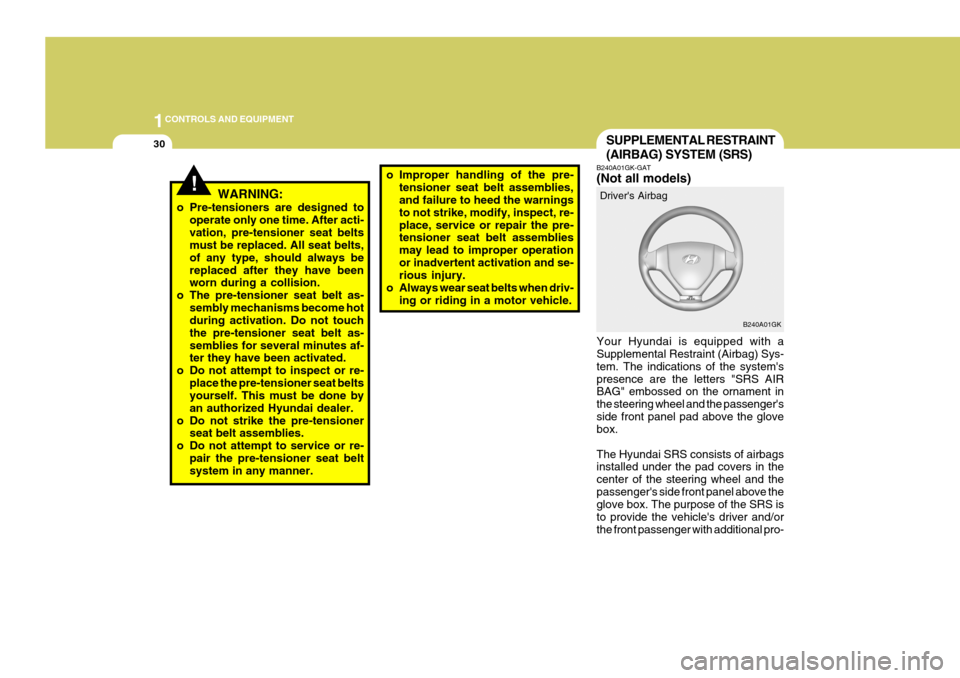
1CONTROLS AND EQUIPMENT
30
o Improper handling of the pre-
tensioner seat belt assemblies, and failure to heed the warnings to not strike, modify, inspect, re-place, service or repair the pre- tensioner seat belt assemblies may lead to improper operationor inadvertent activation and se- rious injury.
o Always wear seat belts when driv- ing or riding in a motor vehicle.
SUPPLEMENTAL RESTRAINT (AIRBAG) SYSTEM (SRS)
B240A01GK-GAT (Not all models) Your Hyundai is equipped with a Supplemental Restraint (Airbag) Sys- tem. The indications of the system'spresence are the letters "SRS AIR BAG" embossed on the ornament in the steering wheel and the passenger'sside front panel pad above the glove box. The Hyundai SRS consists of airbags installed under the pad covers in the center of the steering wheel and thepassenger's side front panel above the glove box. The purpose of the SRS is to provide the vehicle's driver and/orthe front passenger with additional pro- Driver's Airbag
B240A01GK
!WARNING:
o Pre-tensioners are designed to operate only one time. After acti- vation, pre-tensioner seat belts must be replaced. All seat belts, of any type, should always bereplaced after they have been worn during a collision.
o The pre-tensioner seat belt as- sembly mechanisms become hotduring activation. Do not touch the pre-tensioner seat belt as-semblies for several minutes af- ter they have been activated.
o Do not attempt to inspect or re- place the pre-tensioner seat beltsyourself. This must be done by an authorized Hyundai dealer.
o Do not strike the pre-tensioner seat belt assemblies.
o Do not attempt to service or re- pair the pre-tensioner seat belt system in any manner.
Page 211 of 389
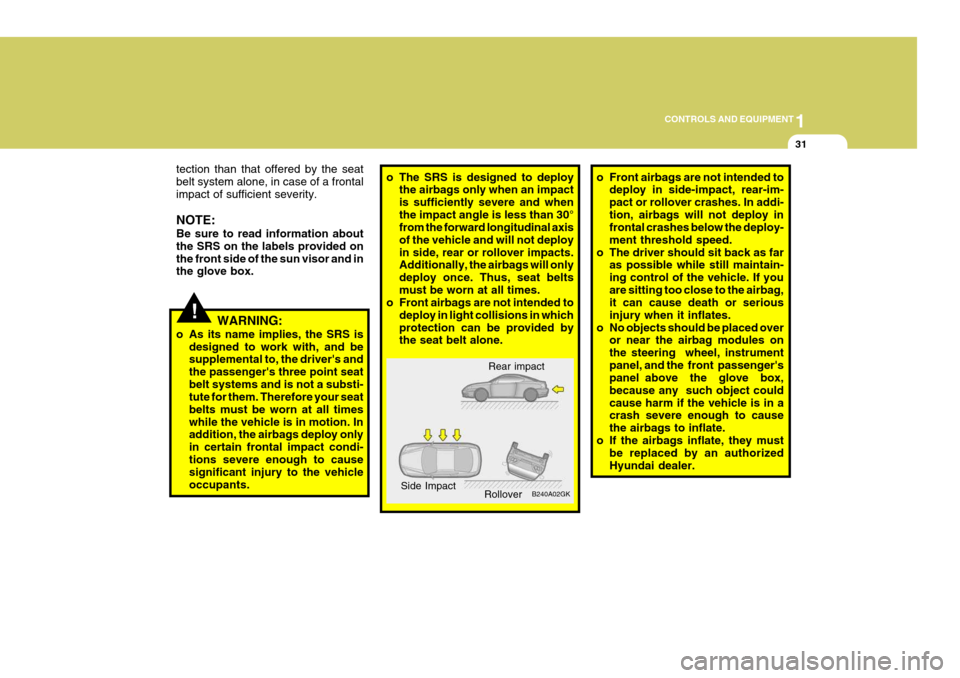
1
CONTROLS AND EQUIPMENT
31
!
tection than that offered by the seat belt system alone, in case of a frontalimpact of sufficient severity. NOTE: Be sure to read information about the SRS on the labels provided onthe front side of the sun visor and in the glove box.
WARNING:
o As its name implies, the SRS is designed to work with, and besupplemental to, the driver's and the passenger's three point seatbelt systems and is not a substi- tute for them. Therefore your seat belts must be worn at all timeswhile the vehicle is in motion. In addition, the airbags deploy only in certain frontal impact condi-tions severe enough to cause significant injury to the vehicle occupants.o The SRS is designed to deploy the airbags only when an impact is sufficiently severe and whenthe impact angle is less than 30° from the forward longitudinal axis of the vehicle and will not deployin side, rear or rollover impacts. Additionally, the airbags will only deploy once. Thus, seat beltsmust be worn at all times.
o Front airbags are not intended to
deploy in light collisions in whichprotection can be provided by the seat belt alone. o Front airbags are not intended to
deploy in side-impact, rear-im- pact or rollover crashes. In addi-tion, airbags will not deploy in frontal crashes below the deploy- ment threshold speed.
o The driver should sit back as far as possible while still maintain-ing control of the vehicle. If youare sitting too close to the airbag, it can cause death or serious injury when it inflates.
o No objects should be placed over or near the airbag modules onthe steering wheel, instrumentpanel, and the front passenger's panel above the glove box, because any such object couldcause harm if the vehicle is in a crash severe enough to cause the airbags to inflate.
o If the airbags inflate, they must be replaced by an authorizedHyundai dealer.
Rear impact
B240A02GK
Side Impact
Rollover
Page 212 of 389

1CONTROLS AND EQUIPMENT
32
tion to minimize the risk of se- vere injury or death in the event of a crash. Do not sit or lean unnecessarily close to the airbagwhile the vehicle is in motion.
o The SRS airbag system must
deploy very rapidly to provideprotection in a crash. If an occu- pant is out of position because of not wearing a seat belt, theairbag may forcefully contact the occupant causing serious or fa- tal injuries. B240B02GK-AAT SRS Components and Functions The SRS consists of the following com- ponents: - Driver's Side Airbag Module - Passenger's Side Airbag Module - SRS Service Reminder Indicator (SRI)- SRS Control Module (SRSCM) The SRSCM continually monitors all elements while the ignition is "ON" to determine if a frontal or near-frontal impact is severe enough to requireairbag deployment.B240B01L-R
o Do not tamper with or discon-
nect SRS wiring, or other com-ponents of the SRS system. Do-ing so could result in injury, due to accidental firing of the airbags or by rendering the SRS inopera-tive.
o Do not install a child restraint
system in the front passengerseat position. A child restraint system must never be placed in the front seat. The infant or childcould be severely injured or killed by an airbag deployment in case of an accident.
o Do not allow children to ride in the front passenger seat. If olderchildren (teenages and older)must ride in the front seat, make sure they are always properly belted and that the seat is movedback as far as possible.
o For maximum safety protection
in all types of crashes, all occu-pants including the driver should always wear their seat belts whether or not an airbag is alsoprovided at their seating posi-